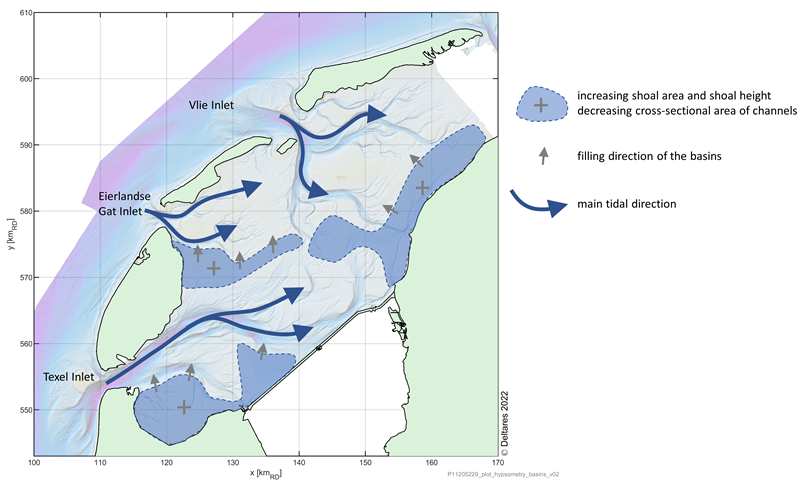B.T. Grasmeijer1,2*, L. Jaksic1, J. Vroom1, J. de Vries3, E. Lofvers3
1 Deltares; 2 Utrecht University, 3 Rijkswaterstaat
*corresponding author:
Introduction
The tidal flow in the western Dutch Wadden Sea has strongly been influenced by the closure of the Zuiderzee in 1932. The western Wadden Sea has been subject to net sedimentation since the closure, and is still adapting to this intervention, causing shoal height to accrete more quickly than present sea level rise (e.g. Colina Alonso et al., 2021). Our study focuses on better understanding the coupled evolution of hydrodynamics and morphology on a decadal scale and evaluating the implications for the future morphological evolution of the Western Dutch Wadden Sea.
Methods
We describe the evolution of flow and morphology in the western Dutch Wadden Sea based new model calculations, from the mega-scale (western Wadden Sea), via macro-scale (tidal basin area) to meso-scale (channels and shoals), with specific focus on the evolution of the (navigation) channels. The effects of four different historical bathymetries (1976, 1991, 2003, 2015) on hydrodynamics have been calculated using the 2D hydrodynamic Dutch Continental Shelf Model in Delft3D.
Results
Our model results show clear trends in hydrodynamics. The tidal prism through the Texel inlet has increased between 1970s and nowadays, while the tidal prism of the Vlie inlet decreased. At the same time, we see high net sedimentation at the landward sides of both basins. The low-lying flat area north of the Texelstroom is eroding and channel re-orientation is taking place. The altered tidal propagation and morphological evolution of the Marsdiep basin causes the tidal prism to increase. In the Vlie basin, the continuous sedimentation at the landward side coincides with a reduction in channel volume, which is consistent with a reduction of the tidal prism. Our results help us understand how seemingly similar accreting behaviour in two adjacent tidal basins result in different effects on the hydrodynamics. We expect these trends of strong sedimentation at the landward side of the basin to continue for the next years to decades, further reducing channel dimensions and increasing the channel maintenance efforts.

Figure 1: Sketch of the developments of the western Dutch Wadden Sea.
References
Colina Alonso, A. et al., 2021. The contribution of sand and mud to infilling of tidal basins in response to a closure dam. Marine Geology, 439(2021), p. 15.
Vroom, J., Elias, E., Lescinski, J., & Wang, Z. B. (2012). Assessment of the Effects of the Zuider Sea Closure on the Hydrodynamics of the Wadden Sea Inlets. Coastal Engineering Proceedings, 1(33), 47. https://doi.org/10.9753/icce.v33.management.47
I. Surname1*, F.N. Another-Surname2 , Y. Next-Surname2
1 University Name, Country; 2 Organization Name, Country
* Corresponding author: mail.name@organization.org


